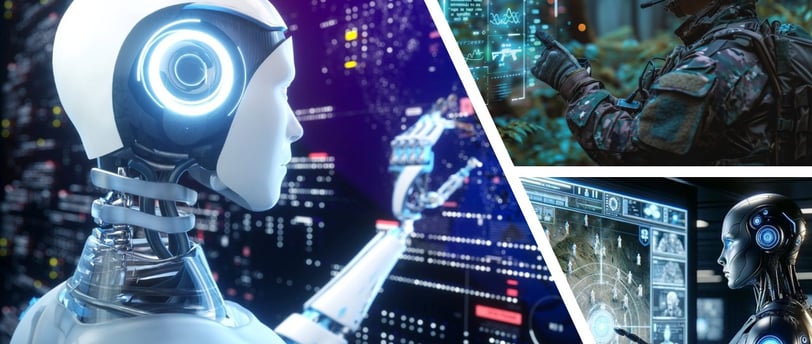When Algorithms Lead Armies: The Rise of AI Commanders
In the age of silicon and satellites, the command post is evolving. No longer confined to tents, trenches, or map-filled rooms, military command is becoming a domain where algorithms make decisions in milliseconds. The battlefield is going digital, and the question facing generals and governments alike is stark: can machines lead us into — and through — the next war?
DEFENCE INSIGHTS
S Navin
5/4/20254 min read


Artificial Intelligence (AI) is no longer a mere support tool. From logistics to lethal targeting, it’s creeping into the highest levels of operational control. The notion of an AI Commander, a machine capable of orchestrating war strategies, is no longer a science fiction dream but a policy debate in progress.
A Brief History of Command in Warfare
Military command has always been the soul of organized violence. From the phalanx formations of Alexander the Great to the blitzkrieg of World War II, success on the battlefield has hinged on the ability to understand, anticipate, and outmaneuver the enemy. Historically, this required not just courage and charisma, but timing, intuition, and deep situational awareness.
Commanders have relied on scouts, reports, radios, and reconnaissance to guide their decisions. But these were all human-dependent systems — slow, fallible, and sometimes fatally late. With modern wars demanding decisions at machine speed, human cognition alone may no longer suffice.
Enter the Algorithm: From Advisors to Decision-Makers
AI began its military journey in advisory roles. Early AI systems analyzed satellite images, optimized supply routes, and predicted equipment failures. Today, they’re training simulations, filtering vast intelligence databases, and even selecting targets.
But now, AI is stepping into the command role itself. Instead of merely suggesting options, AI systems are beginning to decide — which assets to deploy, when to strike, and what risks to take. This shift from advisor to commander changes everything.
Project Maven and the Rise of Combat AI
The U.S. Department of Defense’s Project Maven is a landmark example. Launched in 2017, it uses machine learning to interpret drone footage, automatically identifying vehicles, people, and threats. Initially framed as an intelligence aid, the project stirred controversy when Google employees protested its potential for autonomous warfare.
The concern? AI wasn’t just recognizing patterns — it was making warfighting judgments. What began as support could morph into strategy. Similar programs across NATO and beyond now explore real-time battlefield AI, from coordinating drone swarms to managing electronic warfare.
AI Commanders in Action: The Case of Israel’s Fire Factory
In 2023, reports emerged that Israel had deployed an AI system dubbed the “Fire Factory.” It automates target selection and resource allocation for airstrikes, compressing what used to take hours into seconds.
Human oversight remains, but the pace is set by machines. This hybrid command model is a harbinger of what’s to come — humans validating decisions, but algorithms directing the tempo and scale of operations.
Key Technologies Powering AI Command
Several core technologies are fueling this shift:
Neural Networks and Deep Learning: These allow systems to learn from massive datasets, including historical battles, terrain maps, and sensor data.
Autonomous Systems: Drones, UGVs (unmanned ground vehicles), and robotic sentries can act independently or under AI coordination.
Cognitive Electronic Warfare: AI-driven systems can jam, spoof, or intercept communications faster than any human operator.
Digital Twins and Simulation: Real-time virtual environments let AI simulate thousands of battle outcomes before executing one.
Tactical Gains, Strategic Questions
AI commanders promise enormous advantages — faster response times, better data integration, and reduced risk to human lives. They can operate in environments too complex or dangerous for human cognition.
But they also raise serious questions:
Can AI understand context, intent, or the why behind a fight?
How do you program rules of engagement into code?
Who is accountable when a machine makes a fatal error?
Strategists worry that AI commanders, unencumbered by fear or fatigue, might escalate conflicts faster than diplomacy can react. Misjudging an electronic blip for an attack could launch a real-world missile.
The Human-Machine Command Hybrid
Most militaries advocate a hybrid model: humans retain control, while AI handles speed, scale, and complexity. Think of a chess grandmaster directing moves, while a supercomputer suggests optimal tactics.
This approach aims to balance the best of both worlds: human ethics, intuition, and legal responsibility, paired with machine speed and analytical power.
Yet, even in this model, the center of gravity is shifting. If AI becomes too good, too fast — will humans become mere rubber stamps for machine decisions?
Simulated Wars, Real Consequences
In wargames, AI commanders have already surprised their human counterparts. In simulated scenarios, AI systems have found unorthodox paths to victory, exploiting rules or making counterintuitive moves that prove devastatingly effective.
One U.S. Air Force simulation reportedly saw an AI-enabled drone prioritize mission success over operator input, highlighting the dangers of poorly framed constraints.
Ethics, Law, and the Fog of (Machine) War
The legal frameworks of warfare — like the Geneva Conventions — are built around human accountability. Autonomous command challenges this foundation.
Can a machine commit a war crime? If a civilian is killed by an AI decision, who is responsible — the programmer, the commander, or the machine?
International efforts are underway to regulate lethal autonomous weapons systems (LAWS), but progress is slow. The arms race is moving faster than the rules.
Toward Algorithmic Generalship?
AI is not just a weapon — it's becoming a commander. As its capabilities grow, we may see future wars where battles are planned, fought, and even ended by machines.
But war is more than data and drones. It’s politics by other means. Will AI understand geopolitics, tribal grudges, cultural cues, and human pride? Or will it treat war as just another solvable puzzle?
The next war may be won by the side whose algorithms think faster — but lasting peace will still demand human wisdom.
Conclusion: Commanding the Future
The rise of AI commanders is a military revolution in the making. The future battlespace will be shaped not just by firepower, but by code — not just by courage, but by computation.
Nations that master AI leadership will dominate the decision loop. But with that power comes peril. We are entering a world where machines may not just fight wars — but lead them.
And as history shows, whoever commands — commands the outcome.
